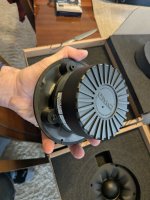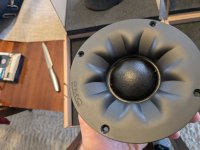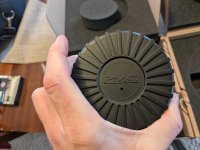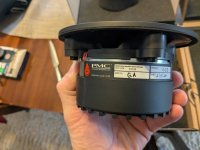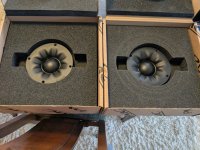Finally got around to properly setting up my Selah Tanzanite speakers designed by the late Rick Craig. Fountek ribbons, 7" seas excel midwoofers, pair of 12" Peerless subs, and Morel MDM 55's for mids. Most uncluttered midrange I've heard. Reminds me a bit of Magnepan's I used to own, but I feel like these have more dynamics. No edginess at all. Really loving them now.
Last edited:
"...make the midrange driver a device that must handle much more power than a tweeter. This imposes harsh demands on the rigidity of the diaphragm, and it exposes the simple suspension to rocking modes.
The reason conventional cones have a separate surround and an inner spider is to constrain the cone travel to a back-and-forth piston motion. Only very expensive mid domes intended for professional studio monitors (like the ATC) use a separate spider; as a result, most consumer-grade domes have serious problems with side-to-side rocking and other spurious motions."
Would ferrofluid suppress these rocking modes at all?
The reason conventional cones have a separate surround and an inner spider is to constrain the cone travel to a back-and-forth piston motion. Only very expensive mid domes intended for professional studio monitors (like the ATC) use a separate spider; as a result, most consumer-grade domes have serious problems with side-to-side rocking and other spurious motions."
Would ferrofluid suppress these rocking modes at all?
@Bryguy FF would have minimal effect on dome rock and wobble. The reason for this is how the undesired motion is aggravated. At and closer to Fs the problems are provoked by the (lack of) air load on both sides of the dome.
When the back chamber is too big, the main restorative force on the dome is lost. The remaining corrective force is the little bit of electromagnetic dampening (back EMF). Based on the spec sheet, this isn't anything significant enough to make a difference. Therfore, you'll need to lower the suspension compliance via a smaller back chamber.
The most effective thing to do is keeping the dome from playing any frequencies closer to Fs, specifically just above it. The CSD data will reveal how much extra motion there is. This needs to be done at relatively high drive levels to ensure catching the entire range of misbehaving motion. Sometimes all it takes is a parallel LCR or even just a resistor. It just depends on the overall severity of the CSD.
When the back chamber is too big, the main restorative force on the dome is lost. The remaining corrective force is the little bit of electromagnetic dampening (back EMF). Based on the spec sheet, this isn't anything significant enough to make a difference. Therfore, you'll need to lower the suspension compliance via a smaller back chamber.
The most effective thing to do is keeping the dome from playing any frequencies closer to Fs, specifically just above it. The CSD data will reveal how much extra motion there is. This needs to be done at relatively high drive levels to ensure catching the entire range of misbehaving motion. Sometimes all it takes is a parallel LCR or even just a resistor. It just depends on the overall severity of the CSD.
I have seen words in German that convey complex/ multifaceted concepts that English does not have a single word for; but then German seems to be structured so that you can put a few words together to make one bigger word.A typical "brain-stress" situation for me, is when you have 8-12 pieces of wood/MDF which must be glued in sequence & simultaneously put under high pressure in a short timeperiod.
And you only have one chance to get it right!
Woodglue also make the surface very slippery.
We have a Swedish word for it, but i don´t know in English.
Does the Swedish word include the aspect of the situation/task being mentally stressful?
"Unwieldy" is the only word I can think of that means "difficult to handle", in a physical sense.
"Unwieldy" is the single word that I can think of that means "too many pieces to physically handle at once (or too big or unsteady) ". "Awkward", or "difficult" or "tricky" or "unmanageable", could apply, but can also apply to more abstract contexts, such as social interactions.
I the USA, we sometimes use a juggling (like in the circus) analogy of "keeping many balls in the air at the same time" which is actually physically like your wood pieces/glue example, but is usually used to mean handling many agenda items, as in a business context. We also say things like "I have a lot on my plate (meaning: dinner plate) right now", which means "I have a lot to do" (maybe too much).
Last edited:
Is this part of the function of the parallel LCR used to tame the resonance near Fs on the DMB-A mid dome? I did use one there, but thought that its function was to allow the filter to make a smooth high pass for the mid, by lowering the impedance.The most effective thing to do is keeping the dome from playing any frequencies closer to Fs, specifically just above it. The CSD data will reveal how much extra motion there is. This needs to be done at relatively high drive levels to ensure catching the entire range of misbehaving motion. Sometimes all it takes is a parallel LCR or even just a resistor. It just depends on the overall severity of the CSD.
Distortion tends to rise towards the Fs on tweeter and midrange domes due to the usually single suspension characteristics. By subduing the domes' tendency to become excited around the resonance via shorting out the out of bandwidth resonance range to ground and allowing it to pass around the dome and not reach it both lowers HD and allows a better rolloff transition, as well as possibly steepening the rolloff due to tanking that range.
Hi Wolf, Thanks for your explanation, it is helpful.
Does "tanking" generally mean diverting, or disposing-of, in this context?
I think that you have used the HIVI DMB-A. I am not looking at graphs at the moment, but I remember being generally surprised that this driver's distortion remained very low, even quite well below its Fs. Not asking/stating this to deny your generality about rising distortion around Fs in domes, but to reality-check my own memory/idea about the DMB-A. Do you remember this about it?
Mine did end up being rolled off adequately on its low end, but the idea that the distortion did not rise quickly at lower frequencies, gave me confidence in crossing it around 800hz.
The inexpensive DMB-A was not easy for me to work with, but I have learned by implementing it. I do not tend to reuse the parts from the speakers that I build, and I work with a limited budget, so it is good to not put tons of $$$ into my more minor builds. I also have a lot of crossover parts, many that were surplus/scavenged so the complex crossovers are not as much of a $ factor as they might be, buying new parts.
Does "tanking" generally mean diverting, or disposing-of, in this context?
I think that you have used the HIVI DMB-A. I am not looking at graphs at the moment, but I remember being generally surprised that this driver's distortion remained very low, even quite well below its Fs. Not asking/stating this to deny your generality about rising distortion around Fs in domes, but to reality-check my own memory/idea about the DMB-A. Do you remember this about it?
Mine did end up being rolled off adequately on its low end, but the idea that the distortion did not rise quickly at lower frequencies, gave me confidence in crossing it around 800hz.
The inexpensive DMB-A was not easy for me to work with, but I have learned by implementing it. I do not tend to reuse the parts from the speakers that I build, and I work with a limited budget, so it is good to not put tons of $$$ into my more minor builds. I also have a lot of crossover parts, many that were surplus/scavenged so the complex crossovers are not as much of a $ factor as they might be, buying new parts.
Last edited:
How does a designer achieve that?via shorting out the out of bandwidth resonance range to ground and allowing it to pass around the dome and not reach
Will that lower total system impedance through that band?Distortion tends to rise towards the Fs on tweeter and midrange domes due to the usually single suspension characteristics. By subduing the domes' tendency to become excited around the resonance via shorting out the out of bandwidth resonance range to ground and allowing it to pass around the dome and not reach it both lowers HD and allows a better rolloff transition, as well as possibly steepening the rolloff due to tanking that range.
I recently received my pair of D7608s. After opening the box, I noticed a mark on one of them—about 4 cm long—resembling a trace left by something that had contact with the membrane. It seems unlikely that this occurred during shipping, as the packaging made it almost impossible for anything to contact the domes. Therefore, it probably happened during storage.
I'm a bit irritated by this, but perhaps it won't affect performance. Any comments? I can ship them back if I wanted to.
I'm a bit irritated by this, but perhaps it won't affect performance. Any comments? I can ship them back if I wanted to.
One option could be to take photos and send them to the supplier/Manufacturer and ask for their view.
I would say their current pricing puts them at a point where they should have passed through some kind of QC check for acoustics and visuals. Possibly I am being naïve on that point.
I would say their current pricing puts them at a point where they should have passed through some kind of QC check for acoustics and visuals. Possibly I am being naïve on that point.
My oh my, these are sexy looking.
$380 for the matched pair has me feeling like I got the deal of the century.
As a reminder, this is out of the PMC speaker I heard at AXPONA 2025 and was the absolute BEST mid range I have ever heard. These will be going into a rather large build that involves either Wavecor balanced drive woofers, NE line Peerless, or Satori woofers. Will have to see how well they play the upper mid and treble to see what I want to do with the tweeter.
I like that they come with the waveguide. Now I don't have to reverse engineer that. The build quality here is superb.

$380 for the matched pair has me feeling like I got the deal of the century.
As a reminder, this is out of the PMC speaker I heard at AXPONA 2025 and was the absolute BEST mid range I have ever heard. These will be going into a rather large build that involves either Wavecor balanced drive woofers, NE line Peerless, or Satori woofers. Will have to see how well they play the upper mid and treble to see what I want to do with the tweeter.
I like that they come with the waveguide. Now I don't have to reverse engineer that. The build quality here is superb.
Attachments
Looking forward to some THD over FR at different level measurements to check how low you can use them.
Not every concept needs the SPL of a 3" midrange but 2" often simply don't go low enough.
Not every concept needs the SPL of a 3" midrange but 2" often simply don't go low enough.
Whats the standard here? 2.83v out of the amplifier? I was thinking I mount it flush in a 4x8 sheet to minimize diffraction effects. Getting the off axis response might pose some issues since it's in a giant board. I might just do an on axis near field and far field.Looking forward to some THD over FR at different level measurements to check how low you can use them.
I will calibrate the spl for the measurement
Last edited:
Measure the impedance sweep, and display on a log scale, and we can play the “this is what the amplitude response, and harmonics, will look like” game
I learnt it from @5th element and @DcibeL
I learnt it from @5th element and @DcibeL
- Home
- Loudspeakers
- Multi-Way
- The dome midrange thread
